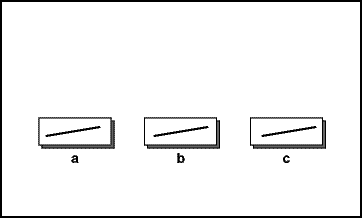Instantiating the Point Objects
Here is a picture of the variables just as the program starts running.
No objects have been instantiated yet, so the reference variables
a, b, and c
do not refer to any object.
To emphasis this, a slash has been put through the box that represents each variable.

Here is the program again:
import java.awt.*; // import the class library where Point is defined
class PointEg1
{
public static void main ( String arg[] )
{
Point a, b, c; // reference variables
a = new Point(); // create a Point at ( 0, 0);
// save the reference in "a"
b = new Point( 12, 45 ); // create a Point at (12, 45);
// save the reference in "b"
c = new Point( b ); // create a Point containing data equivalent
// to the data referenced by "b"
}
}
This program:
- Declares three reference variables
a,b, andc, which may refer to objects of type Point. - Instantiates a Point object with x=0 and y=0.
(The documentation tells us that a constructor without parameters initializes x and y to zero.) - Saves the reference in the variable
a. - Instantiates a Point object with x=12 and y=45.
- Saves the reference in the variable
b. - Instantiates a third Point object.
- Saves the reference in the variable
c.
Once each Point object is instantiated, it is the same as any other (except for the values in the data). It does not matter which constructor was used to instantiate it.
